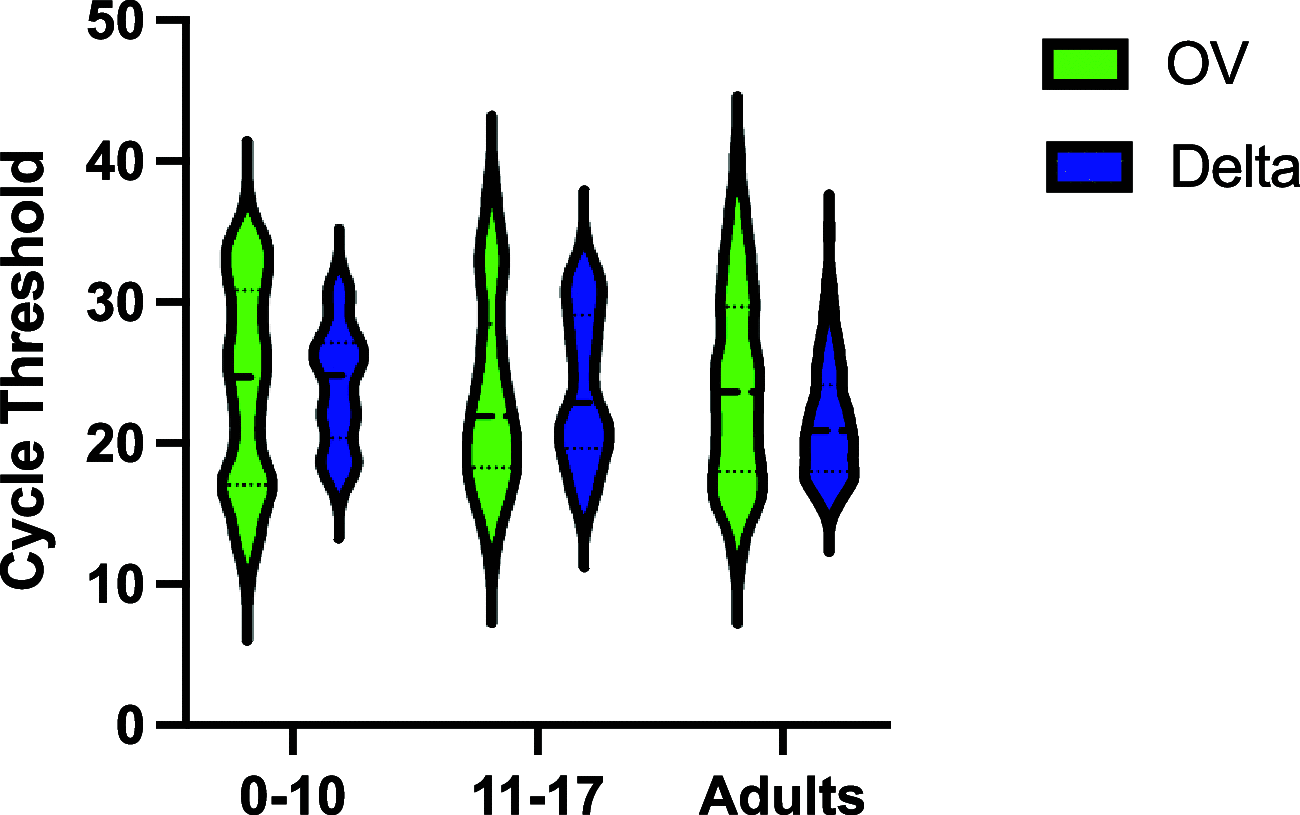Differential Infectivity of Original and Delta Variants of SARS-CoV-2 in Children Compared to Adults
- PMID: 35972128
- PMCID: PMC9602606
- DOI: 10.1128/spectrum.00395-22
Differential Infectivity of Original and Delta Variants of SARS-CoV-2 in Children Compared to Adults
Abstract
Although children of all ages are susceptible to severe acute respiratory syndrome coronavirus 2 (SARS-CoV-2) infection, they have not been implicated as major drivers of transmission thus far. However, it is still unknown if this finding holds true with new variants of concern (VOC), such as Delta (B.1.617.2). This study aimed to examine differences in both viral RNA (as measured by cycle threshold [CT]) and viable-virus levels from children infected with Delta and those infected with original variants (OV). Furthermore, we aimed to compare the pediatric population infection trends to those in adults. We obtained 690 SARS-CoV-2 RT-PCR positive nasopharyngeal swabs from across Manitoba, Canada, which were further screened for mutations characteristic of VOC. Aliquots of sample were then provided for TCID50 (50% tissue culture infective dose) assays to determine infectious titers. Using a variety of statistical analyses we compared CT and infectivity of VOC in different age demographics. Comparing 122 Delta- to 175 OV-positive nasopharyngeal swab samples from children, we found that those infected with Delta are 2.7 times more likely to produce viable SARS-CoV-2 with higher titers (in TCID50 per milliliter), regardless of viral RNA levels. Moreover, comparing the pediatric samples to 130 OV- and 263 Delta-positive samples from adults, we found only that the Delta pediatric culture-positive samples had titers (TCID50 per milliliter) similar to those of culture-positive adult samples. IMPORTANCE These important findings show that children may play a larger role in viral transmission of Delta than for previously circulating SARS-CoV-2 variants. Additionally, they may suggest a mechanism for why Delta has evolved to be the predominant circulating variant.
Keywords: COVID-19; Delta variant; RT-PCR; SARS-CoV-2; TCID50.
Conflict of interest statement
The authors declare no conflict of interest.
Figures



Similar articles
-
Measuring infectious SARS-CoV-2 in clinical samples reveals a higher viral titer:RNA ratio for Delta and Epsilon vs. Alpha variants.Proc Natl Acad Sci U S A. 2022 Feb 1;119(5):e2116518119. doi: 10.1073/pnas.2116518119. Proc Natl Acad Sci U S A. 2022. PMID: 35058348 Free PMC article.
-
Detection of SARS-CoV-2 in Saliva and Nasopharyngeal Swabs According to Viral Variants.Microbiol Spectr. 2022 Dec 21;10(6):e0213322. doi: 10.1128/spectrum.02133-22. Epub 2022 Nov 8. Microbiol Spectr. 2022. PMID: 36346252 Free PMC article.
-
Infectivity of severe acute respiratory syndrome coronavirus 2 in children compared with adults.CMAJ. 2021 Apr 26;193(17):E601-E606. doi: 10.1503/cmaj.210263. Epub 2021 Apr 9. CMAJ. 2021. PMID: 33837039 Free PMC article.
-
Quantitative measurement of infectious virus in SARS-CoV-2 Alpha, Delta and Epsilon variants reveals higher infectivity (viral titer:RNA ratio) in clinical samples containing the Delta and Epsilon variants.medRxiv [Preprint]. 2021 Sep 20:2021.09.07.21263229. doi: 10.1101/2021.09.07.21263229. medRxiv. 2021. Update in: Proc Natl Acad Sci U S A. 2022 Feb 1;119(5):e2116518119. doi: 10.1073/pnas.2116518119. PMID: 34580674 Free PMC article. Updated. Preprint.
-
The role of children in transmission of SARS-CoV-2 variants of concern within households: an updated systematic review and meta-analysis, as at 30 June 2022.Euro Surveill. 2023 May;28(18):2200624. doi: 10.2807/1560-7917.ES.2023.28.18.2200624. Euro Surveill. 2023. PMID: 37140450 Free PMC article.
Cited by
-
Assessing the role of children in the COVID-19 pandemic in Belgium using perturbation analysis.Nat Commun. 2025 Mar 5;16(1):2230. doi: 10.1038/s41467-025-57087-z. Nat Commun. 2025. PMID: 40044649 Free PMC article.
-
Viral infectivity in paediatric SARS-CoV-2 clinical samples does not vary by age.Access Microbiol. 2023 May 26;5(5):acmi000547.v4. doi: 10.1099/acmi.0.000547.v4. eCollection 2023. Access Microbiol. 2023. PMID: 37323941 Free PMC article.
References
-
- Dawood FS, Porucznik CA, Veguilla V, Stanford JB, Duque J, Rolfes MA, Dixon A, Thind P, Hacker E, Castro MJE, Jeddy Z, Daugherty M, Altunkaynak K, Hunt DR, Kattel U, Meece J, Stockwell MS. 2022. Incidence rates, household infection risk, and clinical characteristics of SARS-CoV-2 infection among children and adults in Utah and New York City, New York. JAMA Pediatr 176:59–59. doi:10.1001/jamapediatrics.2021.4217. - DOI - PMC - PubMed
-
- Ladhani SN, Baawuah F, Beckmann J, Okike IO, Ahmad S, Garstang J, Brent AJ, Brent B, Walker J, Andrews N, Ireland G, Aiano F, Amin-Chowdhury Z, Letley L, Flood J, Jones SEI, Borrow R, Linley E, Zambon M, Poh J, Saliba V, Amirthalingam G, Lopez Bernal J, Brown KE, Ramsay ME. 2021. SARS-CoV-2 infection and transmission in primary schools in England in June–December, 2020 (sKIDs): an active, prospective surveillance study. Lancet Child Adolesc Health 5:417–427. doi:10.1016/S2352-4642(21)00061-4. - DOI - PMC - PubMed
-
- Soriano-Arandes A, Gatell A, Serrano P, Biosca M, Campillo F, Capdevila R, Fàbrega A, Lobato Z, López N, Moreno AM, Poblet M, Riera-Bosch MT, Rius N, Ruiz M, Sánchez A, Valldepérez C, Vilà M, Pineda V, Lazcano U, Díaz Y, Reyes-Urueña J, Soler-Palacín P, COVID-19 Pediatric Disease in Catalonia Research Group. 2021. Household severe acute respiratory syndrome coronavirus 2 transmission and children: a network prospective study. Clin Infect Dis 73:e1261–e1269. doi:10.1093/cid/ciab228. - DOI - PMC - PubMed
Publication types
MeSH terms
Substances
Supplementary concepts
LinkOut - more resources
Full Text Sources
Medical
Miscellaneous

